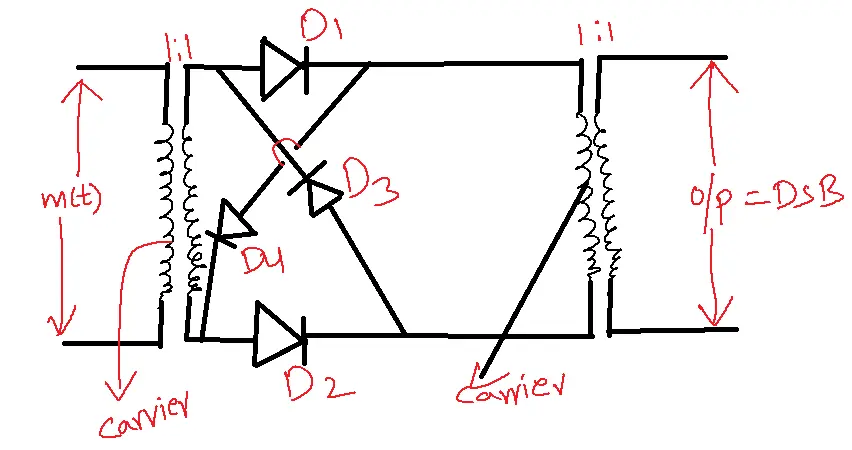Generation of Doble Side Band(DSB) Signals:
Any modulator that generates DSB signals is also called a Product Modulator.

The following two methods are used to generate the DSB signal:
- Balanced Modulator
- Ring Modulator
Table of Contents
Balanced Modulator:

The hardware implementation of the Balanced Modulator consists of two AM modulators.
The input to the first AM modulator is m(t) and the carrier.
s1(t)= Accos2πfct + A Kam(t)cos2πfct
The input to the second AM modulator is –m(t) and the carrier.
The output of the second AM modulator is
s2(t)= Accos2πfct- A Kam(t)cos2πfct
The final output is
s1(t)- s2(t)= 2A Kam(t)cos2πfct 2A Ka= Ac
= Ac m(t)cos2πfct
= DSB.
The output of the balanced modulator is the product of the message and the carrier signifying the DSB signal.
Balanced Modulator is considered as the multiplier.
Ring Modulator:

Assume that the carrier is a periodic rectangular signal in the ring modulator.
The carrier of the ring modulator controls the four diodes D1, D2, D3, and D4.
Case-1: Assume that carrier polarity is positive.
In this case, D1 and D2 are forward biased whereas D3 and D4 are reverse biased. The diodes are ideal so D1 and D2 are replaced with short circuits, and D3 and D4 are replaced with open circuits.
The equivalent circuit diagram is:

Output= m(t).
Case 2: Assume that the carrier polarity is negative. In this case, D1 and D2 are reverse biased whereas D3 and D4 are forward biased.
The equivalent circuit is:

The ring modulator produces an output signal that is the product of m(t) and c(t).

So the output of the ring modulator represents the DSB signal.
The disadvantage of the ring modulator method is the presence of two centre-tapped transformers which occupy more space and are more bulky.
The balanced modulator is very simple to implement compared to the ring modulator.
The most widely used method is the Balanced Modulator.
Applications
Balanced Modulator Applications:
- Double Sideband Suppressed Carrier (DSB-SC) Modulation: By generating AM signals with the carrier signal suppressed, double sideband suppressed carrier (DSB-SC) modulation reduces bandwidth requirements and improves power efficiency.
- Single Sideband (SSB) Modulation: Creates SSB signals from DSB-SC, further reducing bandwidth and improving signal-to-noise ratio (SNR), essential for long-distance communication.
- Quadrature Amplitude Modulation (QAM): Combines amplitude and phase modulation to achieve higher data rates in digital communication systems like Wi-Fi and cable modems.
- Frequency Division Multiplexing (FDM): Enables multiple signals to be transmitted simultaneously over a single communication channel by shifting each signal to a different frequency band.
- Phase-Shift Keying (PSK): A digital modulation scheme where the phase of the carrier signal is varied to represent digital data, used in satellite and wireless communication.
Ring Modulator Applications:
- Frequency Mixing: Combines two input frequencies to produce sum and difference frequencies, utilized in radio receivers, frequency synthesizers, and music synthesizers.
- Frequency Shifting: Shifts the frequency spectrum of a signal up or down, used in radar systems, Doppler effect measurements, and audio effects processing.
- Amplitude Modulation (AM) Detection: Demodulates AM signals to recover the original audio or data.
- Audio Effects: Creates unique audio effects like ring modulation, tremolo, and vibrato in music synthesizers and audio processors.
- Signal Processing: Used for various signal processing tasks, including filtering, modulation, and demodulation in communication systems and electronic instruments.
FAQs related to the topic
Q1. What is a balanced modulator, and how does it differ from a regular modulator?
- A balanced modulator suppresses the carrier signal in amplitude modulation, improving power efficiency and reducing bandwidth.
Q2. What are the main applications of balanced modulators in communication systems?
- They generate DSB-SC and SSB signals, which are required for long-distance radio transmission, along with various digital modulation methods such as QAM.
Q3. How does a ring modulator work, and what is its primary function?
- A ring modulator is a mixer that generates sum and difference frequencies when two input signals are applied. It is frequently used in frequency mixing and shifting applications.
Q4. What are the key differences between a balanced modulator and a ring modulator?
- Balanced modulators suppress the carrier signal, while ring modulators generate both sum and difference frequencies.
Q5. How are balanced modulators used in Single Sideband (SSB) generation?
- They are used to create DSB-SC signals, filtered to obtain the desired upper or lower sideband, resulting in SSB.
Q6. What are some common applications of ring modulators in audio processing?
- They create unique audio effects like ring modulation, tremolo, and vibrato, popularly used in music synthesizers and audio processors.
Q7. Can ring modulators be used for amplitude modulation (AM) detection?
- Yes, they can be used in AM detectors to recover the original modulating signal from the AM carrier wave.
Q8. What are the advantages of using balanced modulators in communication systems?
- They offer improved power efficiency, reduced bandwidth, and better signal quality against conventional AM.
Q9. How do ring modulators contribute to frequency synthesis?
- They enable the generation of new frequencies by mixing two input signals, essential in frequency synthesizers used in various electronic devices.
Q10. What role do balanced modulators play in modern digital communication systems?
- They are critical components in the yielding of QAM signals, which are widely utilized in Wi-Fi, cable modems, and other high-speed data communication systems.
